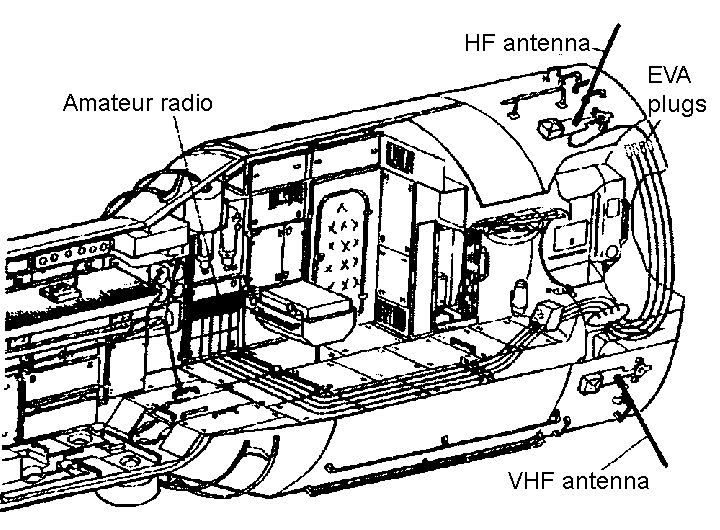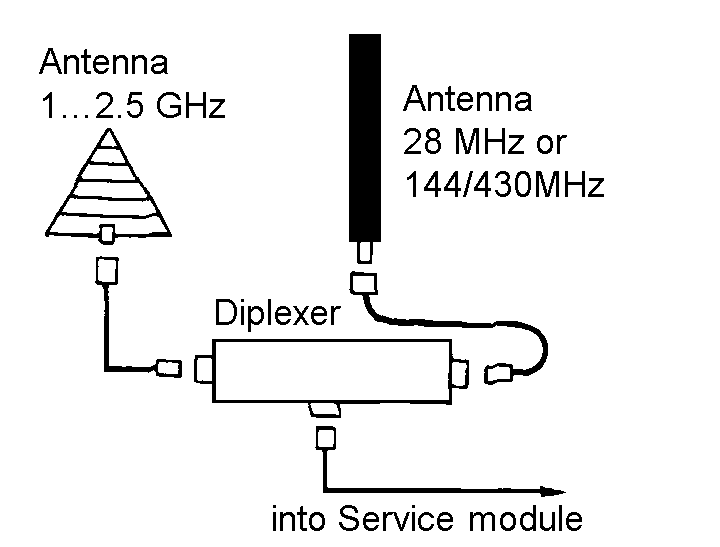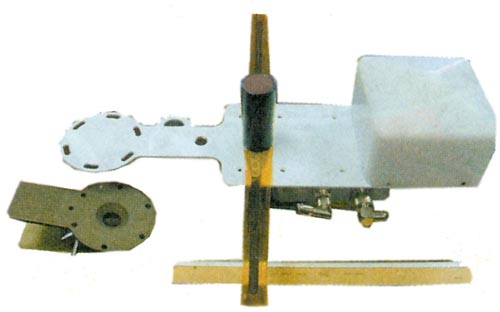Что-то не так?
Пожалуйста, отключите Adblock.
Портал QRZ.RU существует только за счет рекламы, поэтому мы были бы Вам благодарны если Вы внесете сайт в список исключений. Мы стараемся размещать только релевантную рекламу, которая будет интересна не только рекламодателям, но и нашим читателям. Отключив Adblock, вы поможете не только нам, но и себе. Спасибо.
Как добавить наш сайт в исключения AdBlockРеклама
Space experiment (SpEx) "Shadow"
| Information from TsNIIMASH website | Russian page >> |  |
What Amateur radio equipment is present onboard ISS?
The nomenclature and the basic characteristics of the onboard Amateur radio equipment on ISS, are described in the publication: Самбуров С.Н., “На борту международной космической…”, Радио, 2001, № 4, с. 59 (in Russian) and on Web-pages of ARISS and AMSAT - public organizations supporting Amateur radio activity on ISS. General features of the available antenna system are presented below.
Four regular VHF and HF aerials are mounted on the Service module by the crew of the third expedition, as shown in Fig. 1.

Fig. 1. Displacement of the antenna systems on the Service module.
The aerials are located on a cylindrical surface of the service module at an angle of 90 degrees to each other. Each of four established antenna systems has a log-periodic aerial of 1…2,5 GHz band and a flagpole HF or VHF aerial connected to a diplexer, as shown in Fig. 2.

Fig. 2. Antenna system circuitry.
Photo in Fig. 6 shows one of four antenna systems. The log-periodic microwave aerial with a protective cap is mounted on the right of a plate. In its centre there is a fastening element for the HF or VHF flagpole and also you can see a "clothes-peg" for fastening of the plate to a handrail on a surface of the service module. Diplexer is mounted under the plate.
Three antenna systems are identical (include microwave aerial and flagpole on a range of 144 and 432 MHz), and the fourth differs by that the aerial on a range of 10 m is established instead of VHF aerial.

Fig. 3. Antenna system photo.
What type radio do I need?
Typically any packet radio that you already have available. Actually you need only a shortwave receiver to join the experiment. Antenna and, generally, the problem how to equalize network sensitivity, is a subject of further discussion. The simplest vertical flagpole antenna may be a proper choice.
How will be performed “cold” experiments?
While performing “cold” experiments "Shadow-beacon" the task of every individual participant is to register moments of signal appearance and following signal vanish using the Time marks and to address this information along with data on its geographical position to the Information Storing Center. Every operation sequence would take up to 20 min. while the satellite is passing over the given measuring field.
Certain sessions of these experiments may be conducted in a digipeater mode. In this case as ISS approaches a given measuring field, one of western stations of this field takes up a function of a master station and sends to the ISS’s digi a sounding signal (marks of time). The remaining stations of the measuring field start registration of the digipeated signal as they occur to be within of ISS footprint. It may take up to 20 min until you are within of ISS footprint. Further the function of a master station is taken up by one of eastern stations.
Some field stations (in the center of the measuring field) may pick up signals of the western and the eastern master stations both in turn. Some will receive no useful signals. It is also an important observation.
During the session as it begins, i.e. before the beacon actually appears in air, the operators of the field stations should record Log-files and further keep it in memory for a while. We may demand it for analysis.
Your report (the recorded Log-file) with short comments, please, send to the Information Storing Center (Показать Email ) and to Показать Email , while in an arbitrary form. Designate theme of the message as shadow-beacon. In future the procedure of data presentation will be formalized.
More information can be found at LUXORION web page
Personnel
SpEx "Shadow" program supervisor - Valery Borisov, deputy director of TSNIIMASH,
principal investigator - project author Valentin Strashinski (TSNIIMASH).
Onboard beacon operators – from ISS crew.
On-ground receiving network operators - YOU!
Welcome to "Shadow" project team!
Let us do this job together!